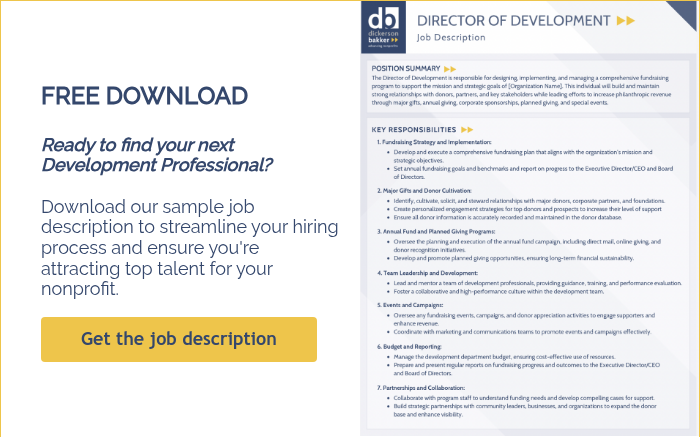Hiring the right executive director can make or break a nonprofit. You need someone who not only understands your mission but can lead your team, manage operations, and build strong relationships with donors, board members, and the community. It’s a big role, and finding the right fit isn’t always easy.
If you're feeling a little overwhelmed by the process, these tips will help simplify your search and set you up to find a leader who’s ready to take your organization to the next level.
Understanding the Role of an Executive Director
The executive director is the heartbeat of a nonprofit, part visionary, part operator, and part relationship-builder. They’re the person responsible for steering the organization toward its mission, making sure day-to-day operations run smoothly while keeping an eye on long-term goals. From overseeing staff and managing budgets to representing the organization in the community, their influence touches every corner of the nonprofit.A big part of their job is working closely with the board of directors. Together, they shape the direction of the organization by setting strategic goals, creating policies, and ensuring accountability. While the board sets the big-picture vision, the executive director is the one making sure that vision turns into real-world impact. It’s a role that requires strong leadership, adaptability, and a deep understanding of the nonprofit’s purpose.
Six Tips for Hiring an Executive Director
Define Your Needs
Before you start hiring, clarify what your organization needs in an executive director. Do you need someone who’s great at fundraising? Someone who can manage daily operations? Or someone who can lead your team through a big change? Knowing your top priorities helps you find the right person for the job, not just someone with a strong resume.If you skip this step, it’s easy to get distracted by candidates who look good on paper but aren’t the right fit. Maybe they’ve led large teams, but your nonprofit is small. Or maybe they’re great with strategy but don’t enjoy hands-on work. Defining your needs early keeps the hiring process focused and helps you make a smart, informed decision.
Engage Stakeholders
Bringing stakeholders into the hiring process helps ensure you're choosing an executive director who aligns with the needs of the whole organization. Not just the hiring committee. Board members, staff, and even key donors or community partners can offer valuable insights about the kind of leadership the organization needs right now. Their input can highlight priorities you may not have considered and help build a shared vision for the role.
Engaging stakeholders early also builds trust. When people feel heard, they’re more likely to support the new hire and work together toward shared goals. This kind of buy-in is especially important for leadership roles, where strong relationships and clear communication are key to success.
Crafting a Compelling Job Description
A clear, well-written job description is one of the most important tools in attracting the right executive director candidates. It should go beyond a list of duties. This is your chance to communicate your mission, culture, and what makes your organization unique. Be specific about what the role involves, what success looks like, and the skills and experience you’re looking for. If fundraising or community outreach is a big part of the job, say that up front.
Avoid vague or overly broad language. Instead of saying “strong leadership skills,” describe what that looks like in your organization. Will they be managing a team of five? Working closely with the board? Overseeing multiple programs? The more details you provide, the more likely you are to attract candidates who understand the role and are genuinely excited about it.
Effective Recruitment Strategies
Finding the right executive director takes more than posting the job on a few job boards and hoping for the best. A strong recruitment strategy combines multiple methods to reach qualified candidates who not only have the right skills but also align with your mission. Start by tapping into your existing network: board members, staff, and community partners may know someone who’s a perfect fit. From there, expand your search using targeted outreach.
Here are a few effective recruitment strategies to consider:
-
Use specialized job boards like Idealist, Chronicle of Philanthropy, and LinkedIn’s nonprofit sector.
-
Leverage your network by encouraging board members and donors to share the opportunity.
-
Promote the role through newsletters or social media to reach people already engaged with your mission.
-
Partner with a nonprofit recruitment firm like DickersonBakker. Recruitment firms specialize in finding mission-aligned leaders and can help you navigate the search with confidence.
-
Attend relevant conferences or leadership events where potential candidates may already be active.
Using a mix of these approaches will increase your chances of finding someone who’s not just qualified, but genuinely excited to lead your organization forward.
Interviewing and Vetting Candidates
Interviewing and vetting candidates for an executive director role takes more than asking a few standard questions. You need to get a clear picture of their leadership style, how they solve problems, and how well they understand and align with your mission. Use a structured interview process where each candidate is asked the same set of core questions, but leave room to dig deeper based on their answers. It’s also helpful to include multiple stakeholders in the interview process, board members, staff, or key partners, so you can gather a range of perspectives.
Once you’ve interviewed your top candidates, take time to thoroughly vet them. This includes checking references, verifying past roles, and asking follow-up questions if anything feels unclear. You may also want to include a scenario-based exercise, like having them outline how they’d handle a common challenge your organization faces. The goal is to go beyond the resume and understand how they think, lead, and communicate. A careful, thoughtful process will help you avoid costly hiring mistakes and find a leader who truly fits.
Assess Cultural Fit
Hiring someone with the right skills is important, but if they don’t align with your culture, things can fall apart quickly. The executive director sets the tone for the entire organization, so it’s important that they fit in with your values, communication style, and way of working. Whether your culture is collaborative and informal or more structured and traditional, the new leader needs to complement and support that environment.
Assessing cultural fit doesn’t mean hiring someone exactly like everyone else. It’s about finding a leader who respects your mission, understands your team dynamic, and can build strong relationships across the organization. During the hiring process, ask questions that get at how they work with others, handle conflict, and make decisions. The better the fit, the smoother the transition, and the stronger the leadership.
Onboarding and Supporting Your New Executive Director
A strong onboarding process helps set your new executive director up for success from day one. Starting a leadership role at a nonprofit comes with a steep learning curve, new relationships to build, operations to understand, and expectations to meet. A clear, structured onboarding plan ensures they feel supported, aligned with the board and staff, and confident in their role.
Here are a few best practices for onboarding:
-
Assign a board liaison to serve as their main point of contact during the first few months.
-
Schedule one-on-one meetings with key staff, board members, donors, and community partners to build relationships early.
-
Provide key documents like strategic plans, budgets, program reports, and recent board meeting notes to give context.
-
Set short-term goals for the first 90 days so they can make progress without feeling overwhelmed.
-
Offer ongoing check-ins with board leadership to provide feedback and answer questions.
Thoughtful onboarding doesn’t just help your new leader adjust. It sets the tone for a productive, long-term relationship.
Qualities to Avoid in an Executive Director
While it’s important to focus on the skills and traits you do want in an executive director, it’s just as important to watch out for red flags. The wrong hire can lead to confusion, low morale, and even damage to your organization’s reputation. Keep an eye out for qualities or behaviors that may not align with your culture or leadership needs.
Here are a few qualities to avoid:
-
Poor communication skills: If they struggle to clearly explain their ideas or avoid tough conversations, it can create disconnect and confusion.
-
Lack of transparency: An executive director needs to be open and honest, especially when working with staff and the board.
-
Top-down leadership style: Someone who doesn’t value collaboration or input from others may struggle in a nonprofit setting.
-
Unwillingness to adapt: Nonprofits often face change and uncertainty. A rigid leader can slow progress and innovation.
-
Weak financial understanding: Even with a finance team in place, your executive director should be able to read a budget and make informed decisions.
Being clear about what won’t work in the role helps you avoid costly missteps and keeps your hiring process focused on finding a truly effective leader.
Build the Perfect Leadership Team with DickersonBakker
Hiring the right executive director is one of the most important decisions a nonprofit can make. From defining your needs and engaging stakeholders to crafting a clear job description and assessing cultural fit, every step plays a role in finding a leader who can drive your mission forward.
A thoughtful hiring process, paired with effective onboarding and a clear understanding of what to avoid, can make all the difference.
If you need help navigating your executive search, the team at DickersonBakker specializes in connecting nonprofits with mission-driven leaders. Reach out today to learn how we can support your search.




